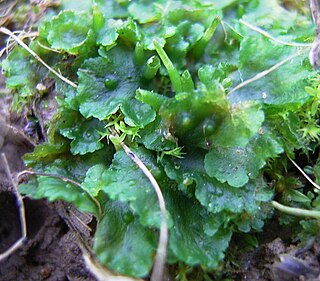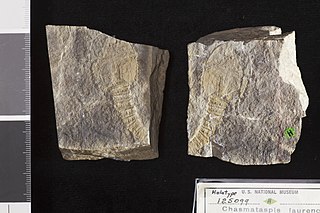
The Cambrian Period is the first geological period of the Paleozoic Era, and of the Phanerozoic Eon. The Cambrian lasted 53.4 million years from the end of the preceding Ediacaran Period 538.8 million years ago (mya) to the beginning of the Ordovician Period 485.4 mya. Its subdivisions, and its base, are somewhat in flux.

The Silurian is a geologic period and system spanning 24.6 million years from the end of the Ordovician Period, at 443.8 million years ago (Mya), to the beginning of the Devonian Period, 419.2 Mya. The Silurian is the shortest period of the Paleozoic Era. As with other geologic periods, the rock beds that define the period's start and end are well identified, but the exact dates are uncertain by a few million years. The base of the Silurian is set at a series of major Ordovician–Silurian extinction events when up to 60% of marine genera were wiped out.

The Marchantiophyta are a division of non-vascular land plants commonly referred to as hepatics or liverworts. Like mosses and hornworts, they have a gametophyte-dominant life cycle, in which cells of the plant carry only a single set of genetic information.

Hornworts are a group of non-vascular Embryophytes constituting the division Anthocerotophyta. The common name refers to the elongated horn-like structure, which is the sporophyte. As in mosses and liverworts, hornworts have a gametophyte-dominant life cycle, in which cells of the plant carry only a single set of genetic information; the flattened, green plant body of a hornwort is the gametophyte stage of the plant.
Cryptospores are microscopic fossilized spores produced by embryophytes. They first appear in the fossil record during the middle of the Ordovician period, as the oldest fossil evidence for the colonization of land by plants. A similar category is miospores, a term generally used for spores smaller than 200 μm. Both cryptospores and miospores are types of palynomorphs.

Prototaxites is a genus of terrestrial fossil fungi dating from the Late Silurian until the Late Devonian periods. Prototaxites formed large trunk-like structures up to 1 metre (3 ft) wide, reaching 8 metres (26 ft) in length, made up of interwoven tubes around 50 micrometres (0.0020 in) in diameter, making it by far the largest land-dwelling organism of its time.

The evolution of plants has resulted in a wide range of complexity, from the earliest algal mats of unicellular archaeplastids evolved through endosymbiosis, through multicellular marine and freshwater green algae, to spore-bearing terrestrial bryophytes, lycopods and ferns, and eventually to the complex seed-bearing gymnosperms and angiosperms of today. While many of the earliest groups continue to thrive, as exemplified by red and green algae in marine environments, more recently derived groups have displaced previously ecologically dominant ones; for example, the ascendance of flowering plants over gymnosperms in terrestrial environments.

Chasmataspidids, sometime referred to as chasmataspids, are a group of extinct chelicerate arthropods that form the order Chasmataspidida. Chasmataspidids are probably related to horseshoe crabs (Xiphosura) and/or sea scorpions (Eurypterida), with more recent studies suggest that they form a clade (Dekatriata) with Eurypterida and Arachnida. Chasmataspidids are known sporadically in the fossil record through to the mid-Devonian, with possible evidence suggesting that they were also present during the late Cambrian. Chasmataspidids are most easily recognised by having an opisthosoma divided into a wide forepart (preabdomen) and a narrow hind part (postabdomen) each comprising 4 and 9 segments respectively. There is some debate about whether they form a natural group.

Polysporangiophytes, also called polysporangiates or formally Polysporangiophyta, are plants in which the spore-bearing generation (sporophyte) has branching stems (axes) that bear sporangia. The name literally means 'many sporangia plant'. The clade includes all land plants (embryophytes) except for the bryophytes whose sporophytes are normally unbranched, even if a few exceptional cases occur. While the definition is independent of the presence of vascular tissue, all living polysporangiophytes also have vascular tissue, i.e., are vascular plants or tracheophytes. Extinct polysporangiophytes are known that have no vascular tissue and so are not tracheophytes.
Spongiophyton was a thallose fossil of the early to mid-Devonian, which is notoriously difficult to classify.
Flatbergiaceae is a family of mosses in the order Sphagnales with a single extant genus, Flatbergium. In addition, an extinct genus, Dollyphyton, based on a fossil from the Middle Ordovician, has been provisionally assigned to this family.

Gregory John Retallack is an Australian paleontologist, geologist, and author who specializes in the study of fossil soils (paleopedology). His research has examined the fossil record of soils though major events in Earth history, extending back some 4.6 billion years. Among his publications he has written two standard paleopedology textbooks, said N. Jones in Nature Geoscience "Retallack has literally written the book on ancient soils."
![<span class="mw-page-title-main">Douglas Lake Member</span> Geologic formation in [[Tennessee]], United States](https://upload.wikimedia.org/wikipedia/commons/thumb/b/bd/Chasmataspis_laurencii_USNM_PAL_125099.jpg/320px-Chasmataspis_laurencii_USNM_PAL_125099.jpg)
The Douglas Lake Member is a geologic unit of member rank of the Lenoir Limestone that overlies the Mascot Dolomite and underlies typical nodular member of the Lenoir Limestone in Douglas Lake, Tennessee, region. It fills depressions that are part of a regional unconformity at the base of Middle Ordovician strata, locally the Lenoir Limestone, that separates them from the underlying Lower Ordovician strata, locally the Knox Group.

Casterlorum is a genus of fossil with controversial interpretation from the Middle Ordovician Douglas Lake Member of the Lenoir Limestone from Douglas Dam Tennessee The genus was named in honor of Ken Caster.

Janegraya is a genus of fossil with controversial interpretation from the Middle Ordovician Douglas Lake Member of the Lenoir Limestone from Douglas Dam Tennessee. The generic name honors Jane Gray, and the epithet means "prophetess".

Dollyphyton is a genus of fossil with controversial interpretation from the Middle Ordovician Douglas Lake Member of the Lenoir Limestone from Douglas Dam Tennessee. The generic name honors Dolly Parton whose Dollywood resort is nearby. The epithet honors Art Boucot.

Edwardsiphyton is a genus of fossil from the Middle Ordovician Douglas Lake Member of the Lenoir Limestone from Douglas Dam Tennessee The genus was named in honor of Dianne Edwards, and the epithet refers to the shape of the capsules.

Chasmataspis is a genus of chasmataspidid, a group of extinct aquatic chelicerate arthropods. It was found in the Early Ordovician deposits of Tennessee, United States.

Palaeoglomus is a genus of microscopic mycorrhizal fossil, found in palynological preparations of rocks which separate out organic remains by acid dissolution.

Douglasocaris is a genus of bivalved arthropod from the Middle Ordovician Douglas Lake Member of the Lenoir Limestone from Douglas Dam Tennessee.













![<span class="mw-page-title-main">Douglas Lake Member</span> Geologic formation in [[Tennessee]], United States](https://upload.wikimedia.org/wikipedia/commons/thumb/b/bd/Chasmataspis_laurencii_USNM_PAL_125099.jpg/320px-Chasmataspis_laurencii_USNM_PAL_125099.jpg)





